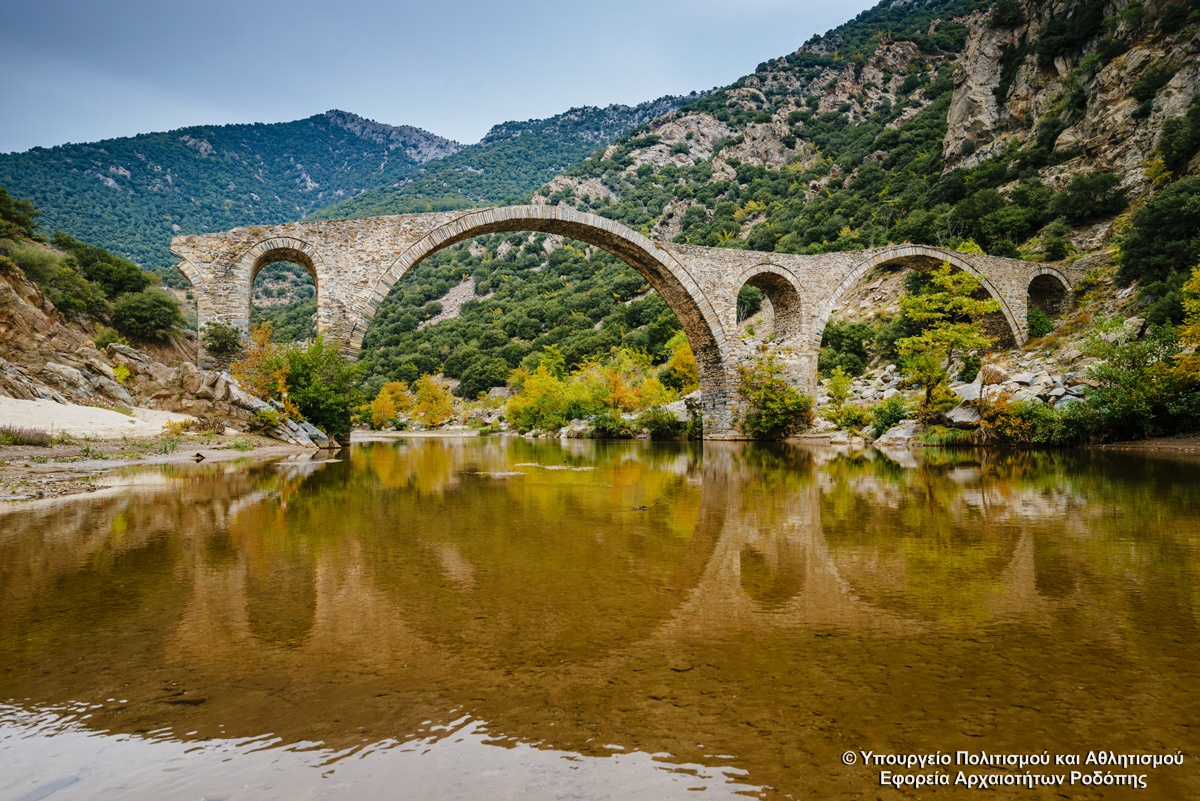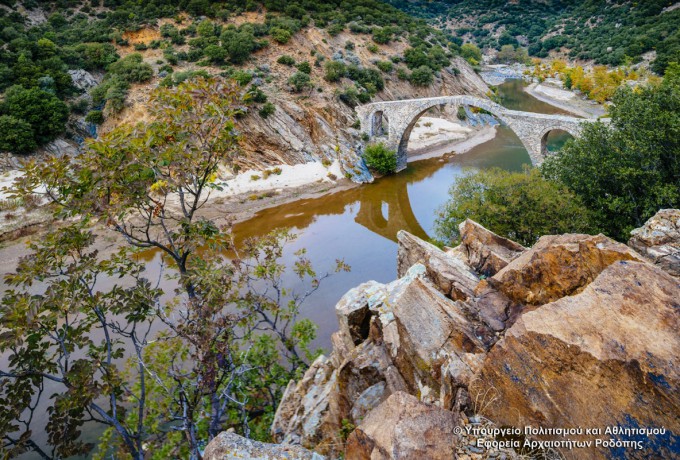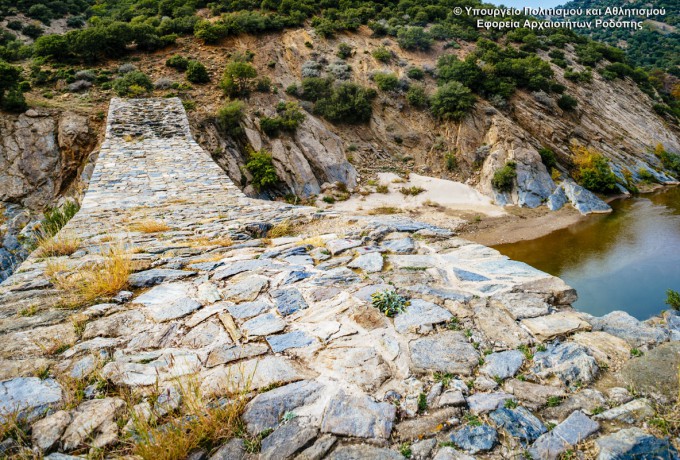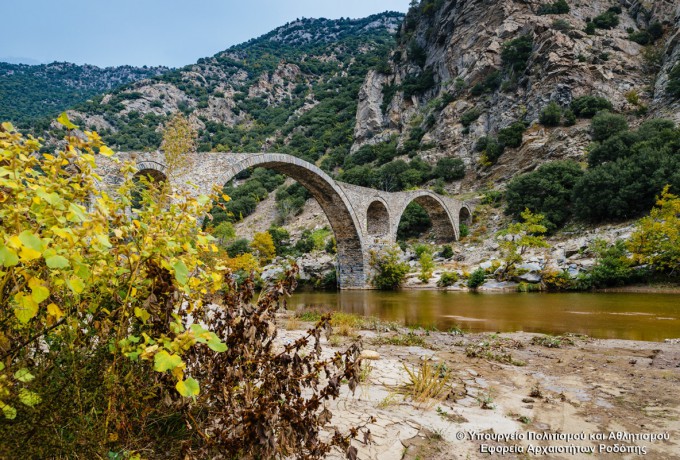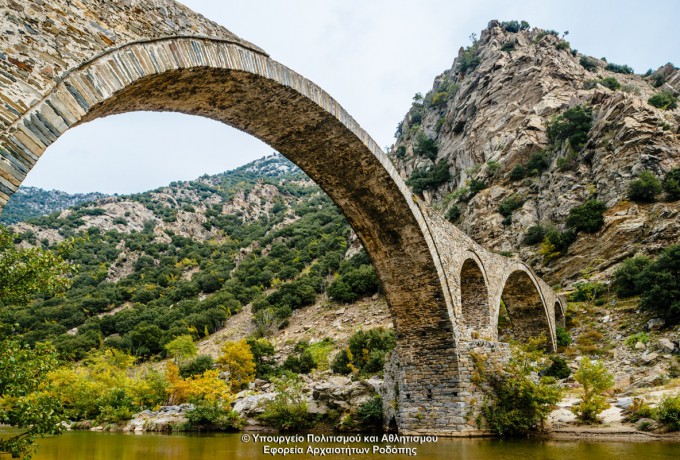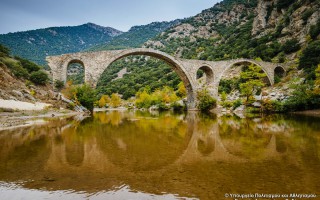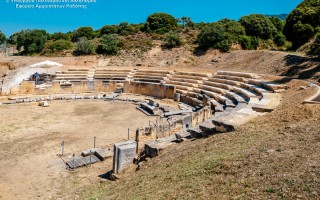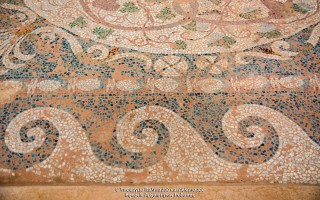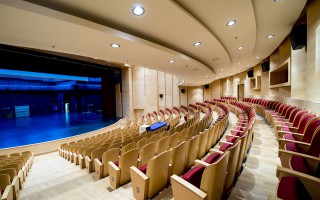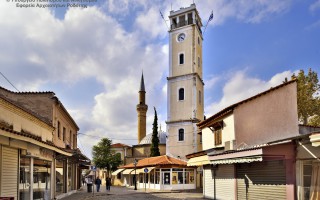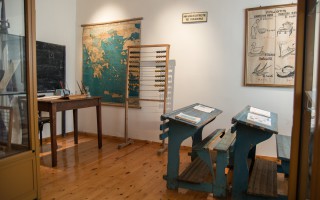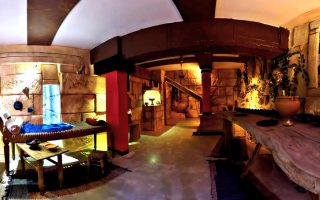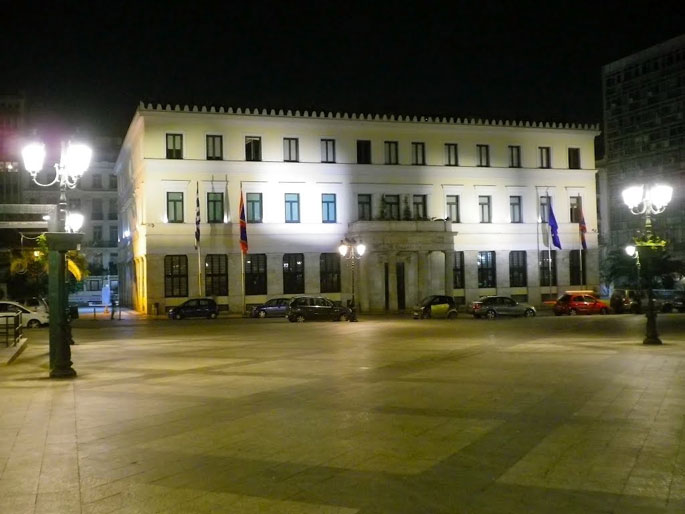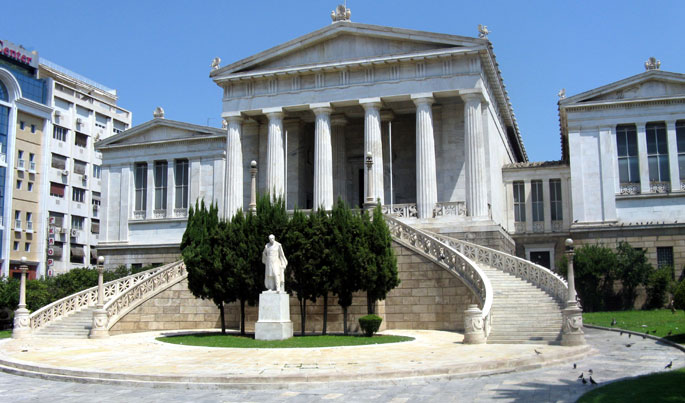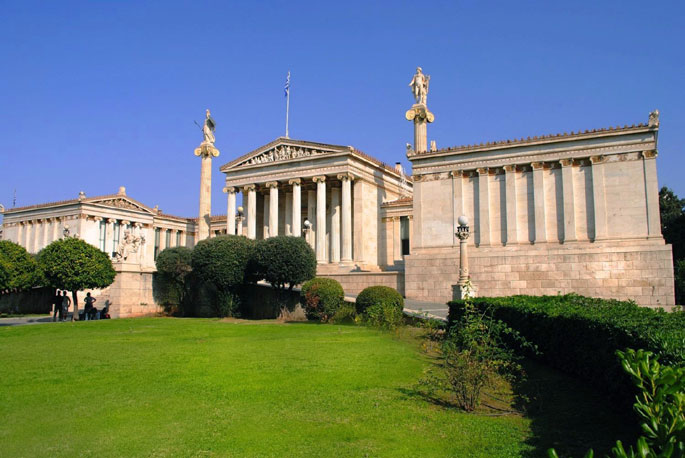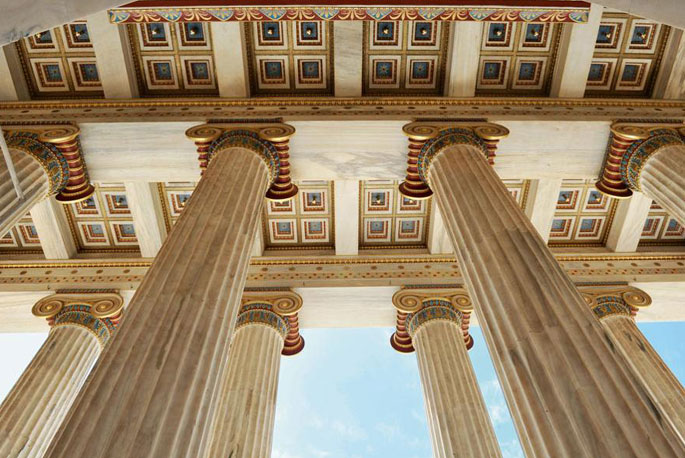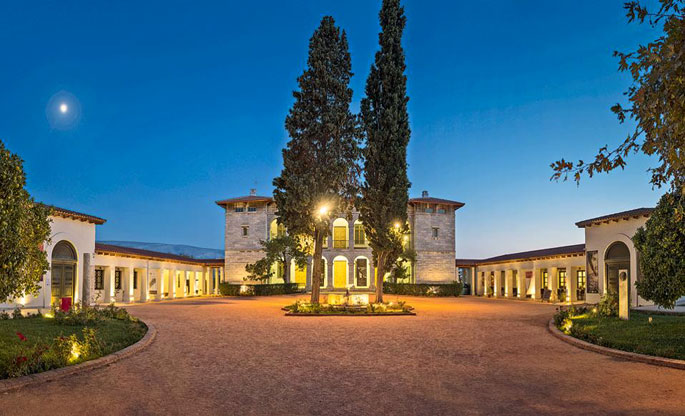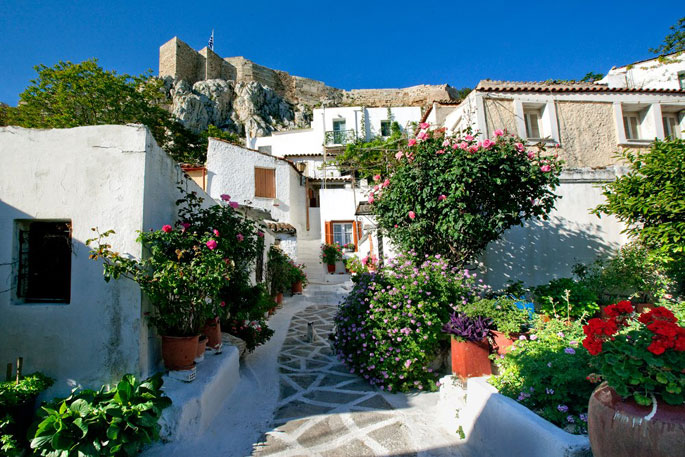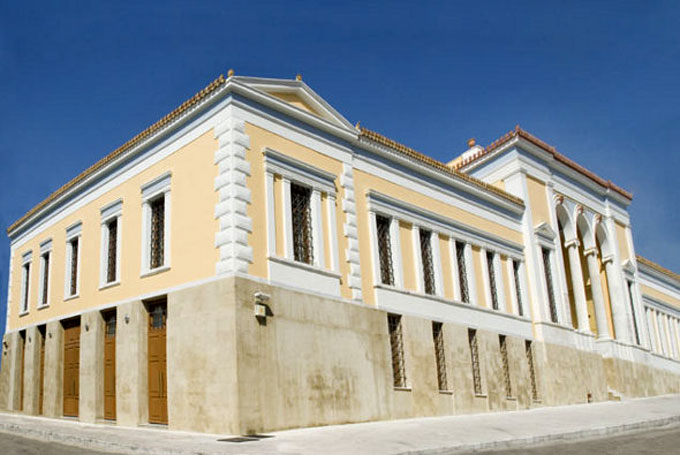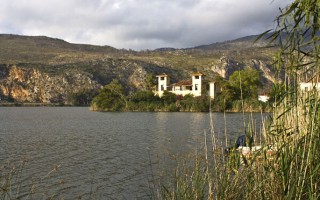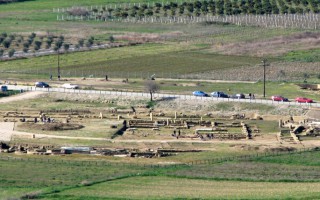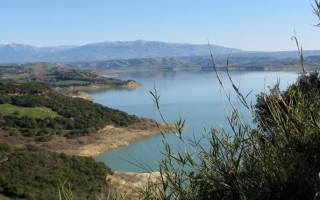The bridge is located at the exit of Kompsatos, which stems from mountainous Rodopi, is crossed Thracian valley and empties into Lake Vistonida.
In the surrounding area have identified several sites with pre-Christian and Christian antiquities with main Byzantine castle of Polyanthos and an aisled basilica between the village of Polianthos and the bridge.
The three-arched bridge was with two piers and two abutments and direction from West to East. Today survives the middle and eastern arc and the eastern abutment. The middle arc which was slightly raised was the larger. Is open 21.80 m and a height of 12 meters The east has opening 17 m. On two piers are relievers openings with flat base and arched roof. Considered a work of craftsmen from Epirus. It dates to 17th-18th century.
Source: Eastern Macedonia & Thrace
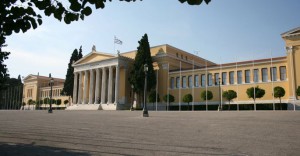 Located next to the National Gardens, the Zappeion Mansion, or simply, “Zappeion,” as it is called by the locals, is one of the most impressive and important historical buildings in Athens. As early as 1859, the Greek Government had been contemplating renovation of the structure, using plans drawn up by Greek architect, Theophilas and his French counterpart, Boulanger. And though well-funded by Greek benefactor, Evangelos Zappas, the project never quite got off the ground.
Located next to the National Gardens, the Zappeion Mansion, or simply, “Zappeion,” as it is called by the locals, is one of the most impressive and important historical buildings in Athens. As early as 1859, the Greek Government had been contemplating renovation of the structure, using plans drawn up by Greek architect, Theophilas and his French counterpart, Boulanger. And though well-funded by Greek benefactor, Evangelos Zappas, the project never quite got off the ground.
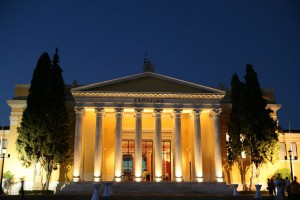 Eventually, however, Danish architect Hanssen became involved and the project was finally given the green light. The official inauguration took place in 1888 and since then, this building has become one of the primary symbols of modern Athens. During its tenure, the building has been home to an eclectic variety of functions; exhibitions, official ceremonies, the first modern Olympic Games of 1896, and in 1936, the Hellenic Radio Station. Today it serves as a press center for political parties during elections.
Eventually, however, Danish architect Hanssen became involved and the project was finally given the green light. The official inauguration took place in 1888 and since then, this building has become one of the primary symbols of modern Athens. During its tenure, the building has been home to an eclectic variety of functions; exhibitions, official ceremonies, the first modern Olympic Games of 1896, and in 1936, the Hellenic Radio Station. Today it serves as a press center for political parties during elections.
Source: www.athensattica.gr
Designed by architect Panagiotis Kalkos, the old City Hall on Athenas Street was built between 1871 and 1874, during the mayoral reign of P. Kyrakos. Initially constructed as a two-story building with a tile roof and Doric order entrance, it was aesthetically and architecturally related to the adjacent Varvakeios School, a Neo-Classical building, also designed by Kalkos, which was destroyed in 1944.
In the 20th Century, City Hall underwent multiple renovations under mayors Spyros Merkouris in 1901, and Amvrossios Plytas between 1935 and 1937. A third floor was added to the building and extensive work was done on its exterior decoration. In the late 20th Century, the building was declared a listed building, and some of its exterior decorative elements were restored to their 19th century style.
Source: www.athensattica.gr
The imposing building of the National Library is the easternmost of the three-building complex known as the Athenian Trilogy. Built in the 19th century to house the National Library, the University of Athens, and the Academy, the Library was designed by the famous architect, Theophil von Hansen, and financed by the Vallianos family, Greek businessmen of the diaspora. Constructed with white Pentelic marble, and enhanced by Doric columns, the building also boasts a stunning, renaissance-style, twin staircase.
The facade and vestibule are decorated with statues of the Vallianos family. It is worth noting that the National Library of Greece was originally established by Governor Ioannis Kapodistrias on the island of Aegina in 1829. At the time, the library’s vast collections were housed in numerous buildings, one of which was the small chapel of Agios Elefterios next the Cathedral. Subsequently, even more library materials were housed in the University of Athens, the two collections finally being merged in 1866, and moved permanently to its current location in 1902.
Source: www.athensattica.gr
This imposing, archaic building was built from 1859 until 1885, and was sponsored by the family of business entrepreneur, Baron Simon Sinas, who then lived in Vienna. Based on plans by Danish architect, Theophile Hanssen, and supervised by Ernst Ziller, the precise location of the construction site had already been selected in 1842, specifically chosen to be part of the famous “Athenian trilogy” of neo-classical buildings.
 Based on Ionian era designs, the building is covered in white Pentelic marble, and its pediments adorned with Peiraic stone; statues of Athena, goddess of Letters, and Apollo, god of the Arts, both created by Leonidas Drossis, are seen standing on two high Ionic order columns overlooking the entrance. Two other impressive statues greet visitors at the entrance escalade, Plato and Aristotle. Though originally drawn by Drossis, these two statues were not completed until after his death. And although the building was ready for occupancy in 1885, the Academy was not officially founded until 1926, when it commenced operations as the supreme research establishment in the country.
Based on Ionian era designs, the building is covered in white Pentelic marble, and its pediments adorned with Peiraic stone; statues of Athena, goddess of Letters, and Apollo, god of the Arts, both created by Leonidas Drossis, are seen standing on two high Ionic order columns overlooking the entrance. Two other impressive statues greet visitors at the entrance escalade, Plato and Aristotle. Though originally drawn by Drossis, these two statues were not completed until after his death. And although the building was ready for occupancy in 1885, the Academy was not officially founded until 1926, when it commenced operations as the supreme research establishment in the country.
Source: www.athensattica.gr
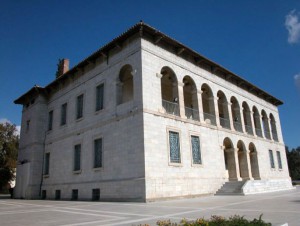 The Byzantine and Christian Museum on Vasilissis Sofias street is one of the most important Byzantine and post-Byzantine era museums in the world, with more than 25.000 objects dating from the 2nd century A.C. to the present. Containing exhibits acquired not only from Greece, but from Asia Minor and the Balkans as well, the museum, housed in the Villa Ilissia, is a magnificent example of 19th century architecture, dating from the earliest years of Greece’s liberation.
The Byzantine and Christian Museum on Vasilissis Sofias street is one of the most important Byzantine and post-Byzantine era museums in the world, with more than 25.000 objects dating from the 2nd century A.C. to the present. Containing exhibits acquired not only from Greece, but from Asia Minor and the Balkans as well, the museum, housed in the Villa Ilissia, is a magnificent example of 19th century architecture, dating from the earliest years of Greece’s liberation.
Designed by renowned Greek architect, Stamatios Kleanthis, the complex was originally built for the Duchess of Placentia, who had lived in Athens for many years. The main structure, a two-story building with a basement, was the Duchess’ primary residence. After her death, ownership of the property was transferred to the state, along with the other buildings in the complex. In 1926 the complex was assigned to house the Byzantine and Christian Museum and, after necessary alterations, opened its doors.
Museum web site:www.byzantinemuseum.gr
Source: www.athensattica.gr
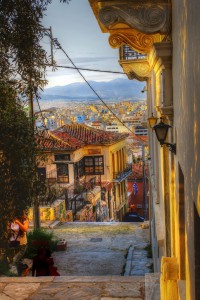 Τhe Anafiotika, one of the oldest neighbourhoods in Athens, was built on the northern slope of the Acropolis by workers and craftsmen from the Cyclades, mostly Anafi. They had flocked to the capital of the new, independent state of Greece, to work at the myriad construction projects underway at the time and, ideally, the massive project at King Otto’s Palace. Local traditions mention Damigos and Sigalas from Anafi as being this neighbourhood’s first inhabitants, followed soon by many more.
Τhe Anafiotika, one of the oldest neighbourhoods in Athens, was built on the northern slope of the Acropolis by workers and craftsmen from the Cyclades, mostly Anafi. They had flocked to the capital of the new, independent state of Greece, to work at the myriad construction projects underway at the time and, ideally, the massive project at King Otto’s Palace. Local traditions mention Damigos and Sigalas from Anafi as being this neighbourhood’s first inhabitants, followed soon by many more.
Tolerated by the authorities, these newcomers started building their homes as they always had in the Cyclades, with their flat roofs connected, and creating a labyrinth of narrow uphill streets, with little stairways carved out of the rock. The whole neighbourhood took on the appearance of a Cycladic installation.
 From 1862 until 1922 the new neighbourhood was inhabited almost solely by islanders from the Cyclades, but then refugees from Asia Minor arrived, making this their new home as well. The inhabitants then began refurbishing and repairing even the smallest, most derelict churches in the area; Ag. Georgios of the Rock, and Ag. Symeon, even adding new belfries. In the 1950’s, part of the neighbourhood was demolished to make room for archaeological excavations. Today only a few houses remain, declared as listed buildings by the state.
From 1862 until 1922 the new neighbourhood was inhabited almost solely by islanders from the Cyclades, but then refugees from Asia Minor arrived, making this their new home as well. The inhabitants then began refurbishing and repairing even the smallest, most derelict churches in the area; Ag. Georgios of the Rock, and Ag. Symeon, even adding new belfries. In the 1950’s, part of the neighbourhood was demolished to make room for archaeological excavations. Today only a few houses remain, declared as listed buildings by the state.
Source: www.athensattica.gr
In the late 19th century, recently naturalized Greek citizen, Ernst Ziller arrived at the town of Pyrgos in order to build the municipal market, Stavropazaro.
The Agora occupies an entire street block. The town’s most significant listed building is a two storey edifice with four entrances and several patios.
Its four sides present four different architectural styles. The façade of Karaiskaki Street has intense Renaissance elements. The façade on Metaxa Street, opposite administrative buildings, has a severe and minimal look while the façade on Kresteniti Street is in pure harmony with the buildings across the street, presenting a similar construction and decoration style. At the fourth façade, on Petralia Street, the possibilities of decoration are restricted by the floor gradient. The ancillary areas are situated on the ground floor which presents a more urban style.
Source: www.mythicalpeloponnese.gr

